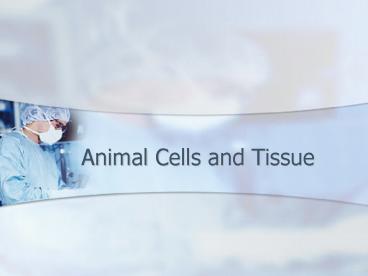Animal Cells and Tissue - PowerPoint PPT Presentation
1 / 29
Title:
Animal Cells and Tissue
Description:
Animal Cells and Tissue 4 Types of Tissue Epithelial Connective Muscle Nervous Epithelial Tissue Skin and Glands Epithelial Tissue Covers body surface and lines ... – PowerPoint PPT presentation
Number of Views:161
Avg rating:3.0/5.0
Title: Animal Cells and Tissue
1
Animal Cells and Tissue
2
4 Types of Tissue
- Epithelial
- Connective
- Muscle
- Nervous
3
Epithelial Tissue
- Skin and Glands
4
Epithelial Tissue
- Covers body surface and lines inside body
cavities. - Functions include
- Lining inside of organs
- Protecting (skin)
- Forming Glands (sweat, mucus, hormone)
5
3 Types of Epithelium Tissue (Shapes)
- Squamous Flattened Cells
- Cuboidal Cube Shaped Cells
- Columnar Elongated Cells
6
Epithelia Tissue
- Epithelium can be simple or stratified.
- Simple One single cell layer (below)
- Stratified More than one cell layer (right ?)
7
Epithelia Tissue - Video
8
Connective Tissue
- Bone, Cartilage, and Blood
9
Functions of Connective Tissue
- Binding, Supporting, and Protective
- Forming Blood
- Storing Fats
- Filling Space
10
Connective Tissue
- Connective cells are separated from one another
by a non-cellular matrix (substance not made of
cells). - Matrix may be
- Solid, as in bone
- Soft, as in Cartilage
- Liquid, as in blood
11
Rigid Connective Tissue
- Cartilage and Bone are Rigid connective tissue
- Cartilage is softer.
- Found in areas such as ears, tip of nose, and at
joints. - Bone is harder.
- Bone has calcium (milk) in the matrix giving it a
greater strength
Cartilage
Bone
12
Connective Tissue Bone Video
13
Liquid Connective Tissue
- Blood is a connective tissue of cells separated
by a liquid matrix. - Two types of cells occur
- Red Blood Cells Carry Oxygen
- White Blood Cells Immune System
Red Blood Cells
14
Connective Tissue
Human Red Blood Cells, Platelets and T-lymphocyte
(erythocytes red platelets yellow
T-lymphocyte light green)
15
Connective Tissue Blood Video
16
Muscle Tissue
- Skeletal, Smooth, and Heart
17
Muscle Tissue
- Muscle Tissue provides movement of the animal by
contraction of individual muscle cells (called
Muscle Fibers). - Three types of muscle fibers
- Skeletal (striated)
- Smooth
- Cardiac (heart)
18
Skeletal Muscle Tissue
- Striated muscle
- Fibers have alternating bands perpendicular to
the long part of the cell. - They function in with the skeletal system for
voluntary muscle movement.
19
Muscle Tissue Skeletal Muscle Video
20
Smooth Muscle Tissue
- Fibers lacking alternating banding.
- These cells function in involuntary movements or
automatic responses - Breathing
- Secretion
- Reflexes
21
Cardiac Muscle Tissue
- Fibers are type of striated muscle found ONLY in
the heart. - The cells have a forked shape, usually with the
nucleus near the center of the cell.
22
Cardiac Muscle Tissue
- Cardiac muscle is special in that its only found
in the heart. Discuss how cardiac muscle has
attributes of both SKELETAL muscle and SMOOTH
muscle.
23
Muscle Tissue
Heart Muscle Cell (nucleus, mitochondria,
actin-myosin)
24
Nervous Tissue
- Neurons and Glia
25
Nervous Tissue
- Nervous Tissue helps your body control the
response to a stimulus (hot, cold, sharp,
smooth). - 2 major divisions CNS and PNS
- CNS Central Nervous System (brain and spinal
cord) - PNS Peripheral Nervous System (nerves and nerve
endings) - Nerve cells are called neurons.
- Close up of a Neuron --------?
26
Nervous Tissue
- Two main cell types Neurons and Glia Cells
- Neurons
- Transmit nerve
- signals.
- Glia
- Often surround
- neurons.
27
Nervous Tissue
- 3 parts of a neuron
- Dendrites
- Cell Body
- Axon
28
Nervous Tissue - Video
29
Nervous Tissue
Pyramidal Neurons from the Central Nervous System































